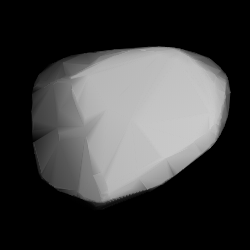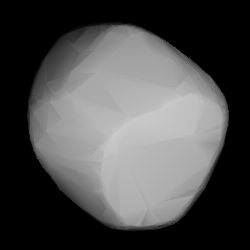Related Research Articles
956 Elisa is a Flora asteroid from the inner regions of the asteroid belt, approximately 10.5 kilometers in diameter. It was discovered on 8 August 1921, by German astronomer Karl Reinmuth at the Heidelberg Observatory. The V-type asteroid has a rotation period of 16.5 hours. It was named after Elisa Reinmuth, mother of the discoverer.
3204 Lindgren, provisional designation 1978 RH, is a carbonaceous background asteroid from the outer regions of the asteroid belt, approximately 20 kilometers in diameter. It was discovered on 1 September 1978, by Soviet astronomer Nikolai Chernykh at the Crimean Astrophysical Observatory in Nauchnij, on the Crimean peninsula. The B-type asteroid has a rotation period of 5.6 hours. It was named after Swedish writer Astrid Lindgren.

1125 China (prov. designation: 1957 UN1) is a dark background asteroid from the outer regions of the asteroid belt. It was discovered on 30 October 1957, by astronomer Zhāng Yùzhé (Y. C. Chang, 张钰哲) at the Chinese Purple Mountain Observatory (紫金山天文台) in Nanjing, and named in honor of the country China. The assumed C-type asteroid has a short rotation period of 5.4 hours and measures approximately 26 kilometers (16 miles) in diameter. Its name and number were actually taken from another asteroid that was considered a lost asteroid at the time, but was eventually rediscovered and given the new designation 3789 Zhongguo. "Zhongguo" means "China" in Chinese (1928 UF).
4060 Deipylos is a large Jupiter trojan from the Greek camp, approximately 84 kilometers in diameter. It was discovered on 17 December 1987, by astronomers Eric Elst and Guido Pizarro at ESO's La Silla Observatory in northern Chile. The transitional C-type asteroid belongs to the 40 largest Jupiter trojans and has rotation period of 9.3 hours. It was named after Deipylos from Greek mythology.

1244 Deira is a dark background asteroid and slow rotator from the inner region of the asteroid belt. The X-type asteroid has an exceptionally long rotation period of 210.6 hours and measures approximately 31 kilometers in diameter. It was discovered on 25 May 1932, by English-born South African astronomer Cyril Jackson at the Union Observatory in Johannesburg, who named it after Deira, an old kingdom near his birthplace, the market town of Ossett, located in West Yorkshire, England.
11665 Dirichlet, provisional designation 1997 GL28, is a Griqua asteroid and a 2:1 Jupiter librator from the outermost regions of the asteroid belt, approximately 6.8 kilometers (4 miles) in diameter. It was discovered on 14 April 1997, by astronomer Paul Comba at the Prescott Observatory in Arizona, United States. The asteroid was named after German mathematician Peter Gustav Lejeune Dirichlet.
7638 Gladman, provisional designation 1984 UX, is a stony background asteroid from the central region of the asteroid belt, approximately 5.8 kilometers in diameter. It was discovered on 26 October 1984, by American astronomer Edward Bowell at Lowell's Anderson Mesa Station near Flagstaff, Arizona. The S-type asteroid has a rotation period of 17.3 hours. It was named after Canadian astronomer Brett J. Gladman.
1710 Gothard, provisional designation 1941 UF, is a stony asteroid from the inner regions of the asteroid belt, approximately 9 kilometers in diameter. It was discovered on 20 October 1941, by Hungarian astronomer György Kulin at the Konkoly Observatory in Budapest, Hungary. It was later named after Hungarian amateur astronomer Jenő Gothard.
1362 Griqua, provisional designation 1935 QG1 is a dark, Jupiter-resonant background asteroid on an eccentric, cometary-like orbit and the namesake of the Griqua group, located in the Hecuba gap in the outermost region of the asteroid belt. The carbonaceous asteroid measures approximately 28 kilometers (17 miles) in diameter and has a rotation period of 6.9 hours. It was discovered on 31 July 1935, by South-African astronomer Cyril Jackson at Union Observatory in Johannesburg. The asteroid was named after the Griqua people in South Africa and Namibia.
11573 Helmholtz, provisional designation 1993 SK3, is a Zhongguo asteroid from the outermost region of the asteroid belt, approximately 13 kilometers (8 miles) in diameter. It was discovered on 20 September 1993, by German astronomers Freimut Börngen and Lutz Schmadel at the Karl Schwarzschild Observatory in Tautenburg, Germany. It is one of few asteroids located in the 2:1 resonance with Jupiter. The asteroid was named for German physicist Hermann von Helmholtz.
1759 Kienle, provisional designation 1942 RF, is a stony background asteroid from the central regions of the asteroid belt, approximately 7 kilometers in diameter. It was discovered on 11 September 1942, by astronomer Karl Reinmuth at the Heidelberg-Königstuhl State Observatory in southwest Germany. The S-type asteroid has a longer-than average rotation period of 29.3 hours. It was named for German astrophysicist Hans Kienle.
4177 Kohman, provisional designation 1987 SS1, is a resonant Griqua asteroid from the outermost regions of the asteroid belt, approximately 11 kilometers (6.8 miles) in diameter. It was discovered on 21 September 1987, by American astronomer Edward Bowell at the Anderson Mesa Station of the Lowell Observatory near Flagstaff, Arizona, in the United States. The asteroid was named for American nuclear chemist Truman Kohman.
3688 Navajo, provisional designation 1981 FD, is a Griqua asteroid and a 2:1 Jupiter librator on an eccentric, cometary-like orbit from the outermost regions of the asteroid belt, approximately 6 kilometers in diameter. It was discovered on 30 March 1981, by American astronomer Edward Bowell at the Anderson Mesa Station near Flagstaff, Arizona. The dark P-type asteroid was named for the Native American Navajo people.
14871 Pyramus, provisional designation 1990 TH7, is a dark Zhongguo asteroid from the outermost region of the asteroid belt, approximately 9 kilometers (6 miles) in diameter. It was discovered on 13 October 1990 by German astronomers Lutz Schmadel and Freimut Börngen at the Karl Schwarzschild Observatory in Tautenburg, Germany. The asteroid was named for Pyramus from classical mythology.
22740 Rayleigh, provisional designation 1998 SX146, is a Zhongguo asteroid from the outermost region of the asteroid belt, approximately 10 kilometers (6 miles) in diameter. It was discovered on 20 September 1998, by Belgian astronomer Eric Elst at the La Silla Observatory in Chile. It is one of few asteroids located in the 2 : 1 resonance with Jupiter. The asteroid was named for English physicist and Nobel laureate Lord Rayleigh.
2975 Spahr, provisional designation 1970 AF1, is a bright background asteroid from the Flora region of the inner asteroid belt, approximately 6 kilometers (3.7 miles) in diameter. It was discovered on 8 January 1970, by Russian astronomers Hejno Potter and A. Lokalov at the Cerro El Roble Station near Santiago, Chile. The S- or A-type asteroid has a rotation period of 11.9 hours. It was named for Timothy Spahr, an American astronomer and former director of the Minor Planet Center.
1922 Zulu, provisional designation 1949 HC, is a carbonaceous asteroid in a strongly unstable resonance with Jupiter, located in the outermost regions of the asteroid belt, and approximately 20 kilometers in diameter. It was discovered on 25 April 1949, by South African astronomer Ernest Johnson at Union Observatory in Johannesburg, and named for the South African Zulu people.
(16882) 1998 BO13, provisional designation 1998 BO13, is a dark Zhongguo asteroid from the background population in the outermost region of the asteroid belt, approximately 10 kilometers (6 miles) in diameter. It was discovered on 24 January 1998, by astronomers with the Lincoln Near-Earth Asteroid Research at the Lincoln Laboratory's Experimental Test Site near Socorro, New Mexico, in the United States.
31249 Renéefleming, provisional designation 1998 DF14, is a dark Zhongguo asteroid from the outermost region of the asteroid belt, approximately 7 kilometers (4 miles) in diameter. It was discovered on 27 February 1998, by astronomers with the ODAS survey conducted at the CERGA Observatory near Caussols, France. The presumed C-type asteroid has a short rotation period of 3.34 hours. It was named for American soprano Renée Fleming.
(38984) 2000 UZ4, provisional designation 2000 UZ4, is carbonaceous Zhongguo asteroid from the outermost regions of the asteroid belt, approximately 5 kilometers (3 miles) in diameter. It was discovered on 24 October 2000, by astronomers with Lincoln Near-Earth Asteroid Research at the Lincoln Laboratory's Experimental Test Site near Socorro, New Mexico, in the United States. The likely elongated C-type asteroid has a rotation period of 19.20 hours.
References
- 1 2 3 4 5 6 7 "3789 Zhongguo (1928 UF)". Minor Planet Center. Retrieved 26 June 2018.
- 1 2 3 4 5 "LCDB Data for (3789) Zhongguo". Asteroid Lightcurve Database (LCDB). Retrieved 26 June 2018.
- ↑ Roig, F.; Nesvorný, D.; Ferraz-Mello, S. (September 2002). "Asteroids in the 2 : 1 resonance with Jupiter: dynamics and size distribution [ Erratum: 2002MNRAS.336.1391R ]". Monthly Notices of the Royal Astronomical Society. 335 (2): 417–431. Bibcode:2002MNRAS.335..417R. doi:10.1046/j.1365-8711.2002.05635.x.
- 1 2 3 "JPL Small-Body Database Browser: 3789 Zhongguo (1928 UF)" (2018-05-23 last obs.). Jet Propulsion Laboratory . Retrieved 26 June 2018.
- 1 2 3 Masiero, Joseph R.; Mainzer, A. K.; Grav, T.; Bauer, J. M.; Cutri, R. M.; Dailey, J.; et al. (November 2011). "Main Belt Asteroids with WISE/NEOWISE. I. Preliminary Albedos and Diameters". The Astrophysical Journal. 741 (2): 20. arXiv: 1109.4096 . Bibcode:2011ApJ...741...68M. doi:10.1088/0004-637X/741/2/68.
- 1 2 Waszczak, Adam; Chang, Chan-Kao; Ofek, Eran O.; Laher, Russ; Masci, Frank; Levitan, David; et al. (September 2015). "Asteroid Light Curves from the Palomar Transient Factory Survey: Rotation Periods and Phase Functions from Sparse Photometry". The Astronomical Journal. 150 (3): 35. arXiv: 1504.04041 . Bibcode:2015AJ....150...75W. doi:10.1088/0004-6256/150/3/75.
- 1 2 3 "Asteroid 3789 Zhongguo". Small Bodies Data Ferret. Retrieved 26 June 2018.
- 1 2 3 Lazzaro, D.; Angeli, C. A.; Carvano, J. M.; Mothé-Diniz, T.; Duffard, R.; Florczak, M. (November 2004). "S3OS2: the visible spectroscopic survey of 820 asteroids" (PDF). Icarus. 172 (1): 179–220. Bibcode:2004Icar..172..179L. doi:10.1016/j.icarus.2004.06.006 . Retrieved 26 June 2018.
- ↑ "MPC/MPO/MPS Archive". Minor Planet Center. Retrieved 26 June 2018.
- 1 2 "Asteroid (3789) Zhongguo – Proper Elements". AstDyS-2, Asteroids – Dynamic Site. Retrieved 22 June 2018.